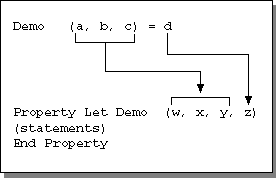下表列出呼叫 屬性程式的語法:
| 屬性程序 | 語法 |
|---|---|
| Property Get | [Set ] varname = [ object.] propname [ ( [arguments] ) ] |
| Property Let | [Let ][ object.] propname [ ( [arguments] ) ] = argument |
| 屬性集 | 設定 [ object.] propname [ ( [arguments] ) ] = objectArg |
屬性過程調用需要至少一個自變數、指 派 (=) 運算元,以及屬性過程名稱。
- 在指派運算 符右側具有屬性名稱的呼叫中,Visual Basic 會呼叫 Property Get 以從類別/物件傳回資訊。
- 在指派運算 符左側具有屬性名稱的呼叫中,Visual Basic 會呼叫 Property Let 或 Property Set 來更新類別物件內的資訊。
如果屬性過程的宣告有多個參數,呼叫 Property Let 或 Property Set,則會將指派運算符右側的 自變數傳遞至 Property Let 或 Property Set 程式的最後一個參數。
例如,下圖使用 Property Let 來顯示屬性過程調用 (頂端) 的自變數如何與下) 上宣告 (中的參數相關:

下列程式代碼範例示範屬性過程自變數和參數之間的關聯性。
'DemoType class declaration
Private pW
Private pX
Private pY
Private pZ
Property Get DemoProperty(w, x, y)
'Calling format is: `z = DemoProperty(w, x, y)`
' or `Set z = DemoProperty(w, x, y)`
w = pW
x = pX
y = pY
If IsObject(pZ) Then
Set DemoProperty = pZ
Else
DemoProperty = pZ
End If
End Property
Property Let DemoProperty(w, x, y, z)
'Calling format is `DemoProperty(w, x, y) = z`
pW = w
pX = x
pY = y
pZ = z
End Property
Property Set DemoProperty(w, x, y, z As Object)
'Calling format is `Set DemoProperty(w, x, y) = z`
pW = w
pX = x
pY = y
Set pZ = z
End Property
Sub DemoSub()
Dim myDemo As Object
Dim a, b, c, d
Dim w, x, y, z
Set myDemo = New DemoType
a = "Hello"
b = ", "
c = "world"
d = "!"
Debug.Print Join(Array(a, b, c, d), "") ' Hello, world!a
'Call Property Let DemoProperty(a, b, c, d)
Let myDemo.DemoProperty(a, b, c) = d
'Call Property Get
d = myDemo.DemoProperty(a, b, c)
Debug.Print Join(Array(a, b, c, d), "") ' Hello, world!
End Sub
在實務上,具有多個自變數之屬性程式的唯一用法是建立屬性陣列。
另請參閱
支援和意見反應
有關於 Office VBA 或這份文件的問題或意見反應嗎? 如需取得支援服務並提供意見反應的相關指導,請參閱 Office VBA 支援與意見反應。